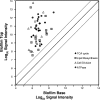Heterogeneity in Pseudomonas aeruginosa biofilms includes expression of ribosome hibernation factors in the antibiotic-tolerant subpopulation and hypoxia-induced stress response in the metabolically active population
- PMID: 22343293
- PMCID: PMC3318454
- DOI: 10.1128/JB.00022-12
Heterogeneity in Pseudomonas aeruginosa biofilms includes expression of ribosome hibernation factors in the antibiotic-tolerant subpopulation and hypoxia-induced stress response in the metabolically active population
Abstract
Bacteria growing in biofilms are physiologically heterogeneous, due in part to their adaptation to local environmental conditions. Here, we characterized the local transcriptome responses of Pseudomonas aeruginosa growing in biofilms by using a microarray analysis of isolated biofilm subpopulations. The results demonstrated that cells at the top of the biofilms had high mRNA abundances for genes involved in general metabolic functions, while mRNA levels for these housekeeping genes were low in cells at the bottom of the biofilms. Selective green fluorescent protein (GFP) labeling showed that cells at the top of the biofilm were actively dividing. However, the dividing cells had high mRNA levels for genes regulated by the hypoxia-induced regulator Anr. Slow-growing cells deep in the biofilms had little expression of Anr-regulated genes and may have experienced long-term anoxia. Transcripts for ribosomal proteins were associated primarily with the metabolically active cell fraction, while ribosomal RNAs were abundant throughout the biofilms, indicating that ribosomes are stably maintained even in slowly growing cells. Consistent with these results was the identification of mRNAs for ribosome hibernation factors (the rmf and PA4463 genes) at the bottom of the biofilms. The dormant biofilm cells of a P. aeruginosa Δrmf strain had decreased membrane integrity, as shown by propidium iodide staining. Using selective GFP labeling and cell sorting, we show that the dividing cells are more susceptible to killing by tobramycin and ciprofloxacin. The results demonstrate that in thick P. aeruginosa biofilms, cells are physiologically distinct spatially, with cells deep in the biofilm in a viable but antibiotic-tolerant slow-growth state.
Figures








Similar articles
-
Contribution of stress responses to antibiotic tolerance in Pseudomonas aeruginosa biofilms.Antimicrob Agents Chemother. 2015 Jul;59(7):3838-47. doi: 10.1128/AAC.00433-15. Epub 2015 Apr 13. Antimicrob Agents Chemother. 2015. PMID: 25870065 Free PMC article.
-
Contribution of Drugs Interfering with Protein and Cell Wall Synthesis to the Persistence of Pseudomonas aeruginosa Biofilms: An In Vitro Model.Int J Mol Sci. 2021 Feb 5;22(4):1628. doi: 10.3390/ijms22041628. Int J Mol Sci. 2021. PMID: 33562782 Free PMC article.
-
Selective Proteomic Analysis of Antibiotic-Tolerant Cellular Subpopulations in Pseudomonas aeruginosa Biofilms.mBio. 2017 Oct 24;8(5):e01593-17. doi: 10.1128/mBio.01593-17. mBio. 2017. PMID: 29066549 Free PMC article.
-
Correlation between biofilm formation and antibiotic resistance in Pseudomonas aeruginosa: a meta-analysis.Infez Med. 2020 Mar 1;28(1):47-54. Infez Med. 2020. PMID: 32172260
-
Hibernating ribosomes as drug targets?Front Microbiol. 2024 Jul 29;15:1436579. doi: 10.3389/fmicb.2024.1436579. eCollection 2024. Front Microbiol. 2024. PMID: 39135874 Free PMC article. Review.
Cited by
-
Wolf in Sheep's Clothing: Clostridioides difficile Biofilm as a Reservoir for Recurrent Infections.Microorganisms. 2021 Sep 10;9(9):1922. doi: 10.3390/microorganisms9091922. Microorganisms. 2021. PMID: 34576818 Free PMC article. Review.
-
Spatially resolved analysis of Pseudomonas aeruginosa biofilm proteomes measured by laser ablation sample transfer.PLoS One. 2021 Jul 22;16(7):e0250911. doi: 10.1371/journal.pone.0250911. eCollection 2021. PLoS One. 2021. PMID: 34292966 Free PMC article.
-
Model of Chronic Equine Endometritis Involving a Pseudomonas aeruginosa Biofilm.Infect Immun. 2017 Nov 17;85(12):e00332-17. doi: 10.1128/IAI.00332-17. Print 2017 Dec. Infect Immun. 2017. PMID: 28970274 Free PMC article.
-
Fungal biofilm architecture produces hypoxic microenvironments that drive antifungal resistance.Proc Natl Acad Sci U S A. 2020 Sep 8;117(36):22473-22483. doi: 10.1073/pnas.2003700117. Epub 2020 Aug 26. Proc Natl Acad Sci U S A. 2020. PMID: 32848055 Free PMC article.
-
Beyond antibiotics: CRISPR/Cas9 triumph over biofilm-associated antibiotic resistance infections.Front Cell Infect Microbiol. 2024 Jul 5;14:1408569. doi: 10.3389/fcimb.2024.1408569. eCollection 2024. Front Cell Infect Microbiol. 2024. PMID: 39035353 Free PMC article. Review.
References
-
- Alhede M, et al. 2009. Pseudomonas aeruginosa recognizes and responds aggressively to the presence of polymorphonuclear leukocytes. Microbiology 155: 3500– 3508 - PubMed
Publication types
MeSH terms
Substances
Associated data
- Actions
Grants and funding
LinkOut - more resources
Full Text Sources
Other Literature Sources
Molecular Biology Databases

